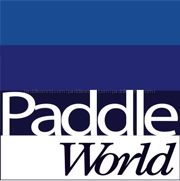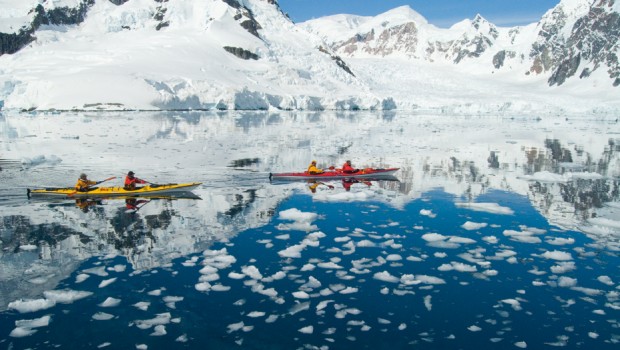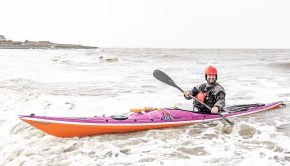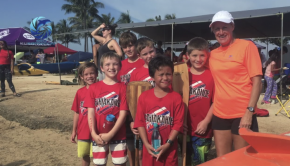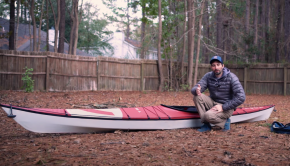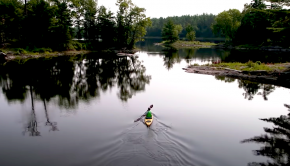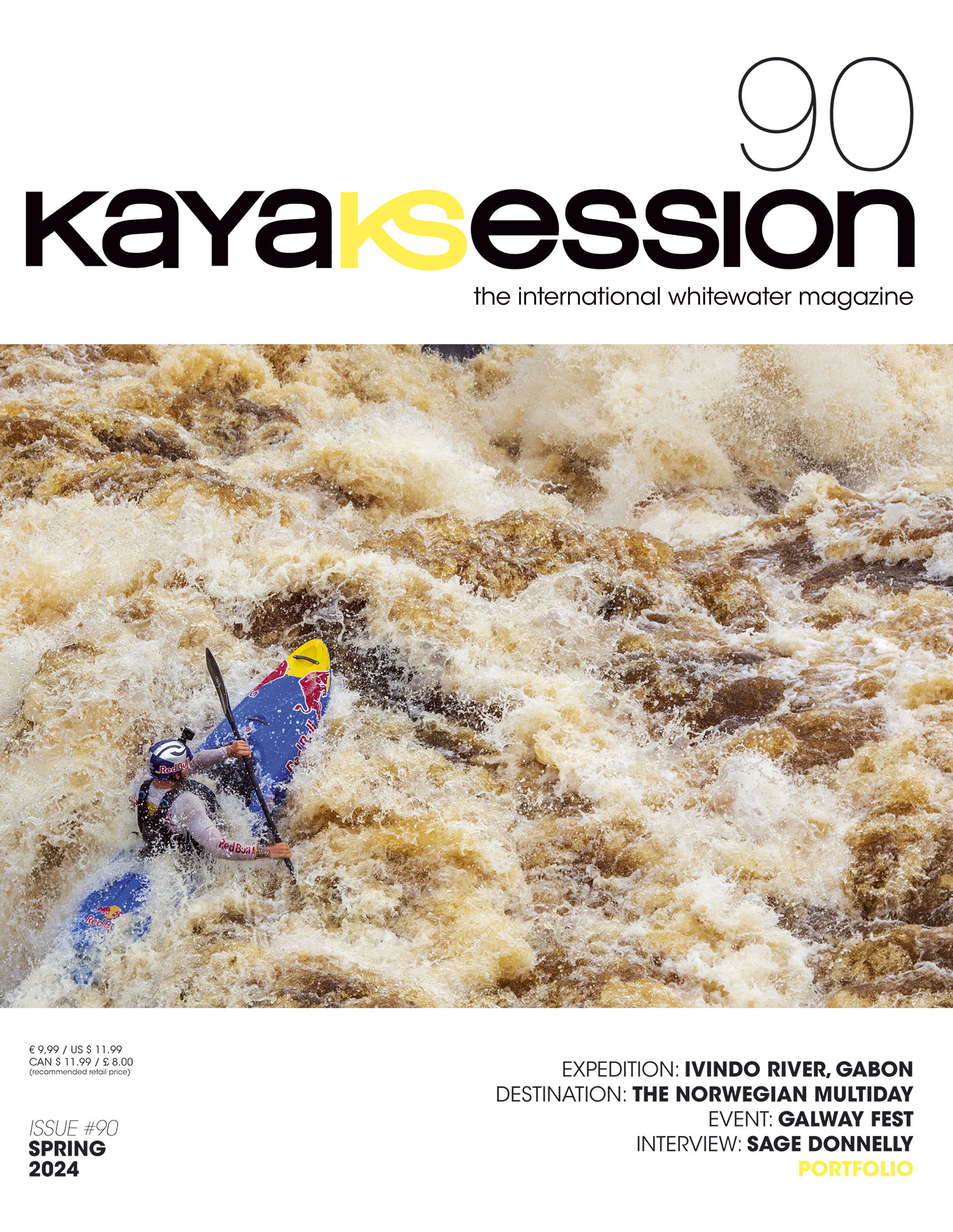ANTARCTICA – TEN REASONS TO LOVE (AND WORRY ABOUT) THE ICE
By John Bowermaster. Photography: ©Peter McBride (www.petemcbride.com) / (published in paddle world mag 2010)
My introduction to Antarctica was exactly 20 years ago, when I first traveled there as part of Will Steger’s “Trans-Antarctica Expedition,” the longest traverse of the seventh continent and the last by dog sled. I’ve been back a couple dozen times since and much has changed in the ensuing two decades, including global concern about the future of Antarctica’s Peninsula. In Antarctica, it’s all about the ice. As the ice changes, especially along the thousand-mile-long Peninsula, it impacts the wildlife, the continent and the scientists who study there. During this journey we discovered ten reasons why the world should be both enchanted by and very concerned for this remote, fragile continent.
1 – Because It Is Planet Earth’s Beating Heart.
If in the final equation the surface of the Earth is a single, complex system, then Antarctica is its heart, the slowly beating pump that drives the whole world. Each austral winter, a 7 million-square mile halo of sea ice forms around the continent, and each spring trillions of tons of fresh water are released into the ocean as it thaws. This is the planet’s great annual climate cycle, the thermodynamic engine that drives the circulation of ocean currents, redistributing the sun’s heat, regulating climate, forcing the upwelling of deep ocean nutrients, setting the tempo of the planet’s weather. The Antarctic affects all our lives, but through forces so deep and elemental that we’re not even aware of them. Conversely, here is where global climate change is most clearly seen. The effects of ozone depletion and global warming are strongest in Polar Regions, where they are reinforced by atmospheric and meteorological conditions. Because Antarctica is essentially uninhabited and without industry, there is virtually no local pollution; any ecological and climate disturbances on the continent are certainly caused by global forces. Global warming models from the early 1970s predicted that climactic effects of human greenhouse gas emissions would be felt first and most strongly at the poles. More than two decades ago scientists prophesied that one of the first signs of human-caused climate change would be the collapse of the Antarctic Peninsula’s ice sheets. This is exactly what is happening. In March 2002 scientists watched the 500-billion-ton Larsen-B ice shelf shatter into thousands of tiny icebergs before their eyes. This past March a 160-mile-square section broke off the Wilkins ice shelf. Two of the 10 shelves along the peninsula have vanished completely within the past 30 years. Another five have lost between 60 percent and 92 percent of their original extent. Of the 10, Wilkins is the southernmost shelf in the area to start buckling under global warming’s effect. What is happening so dramatically, so quickly to those shelves suggests it’s possible the rest of the Peninsula’s ice may deteriorate soon. And fast. Which is one reason we headed to the Peninsula by sea kayak, small plane, foot and sail, to bear witness to this magnificent, fast-changing corner of the world.
2 – For Its Icebergs.
Three days after leaving the southernmost yacht club in the world, at Puerto Williams, Chile, we began our stakeout for one thing Antarctica offers bigger and better than anywhere on the planet: Icebergs. About 200 miles from mainland Antarctica we spied our first and floated by quietly, reverentially. It was easily 100 feet tall, solid and old, its glacial ice so compacted the oxygen had been squeezed out making it evermore blue. Nothing represents Antarctica more powerfully than these floating sentinels. The deck of the 74-foot Pelagic Australis was sheathed in ice, too; we’d sailed hard for four days across the notorious Drake Passage in relatively calm (15-20 foot) seas and were within 75 miles of King George Island, our first stop. Home to a dozen international science bases, it’s where I’d stashed our kayaks five weeks earlier. Where we would head once we’d grabbed the kayaks was up in the air. Each long Antarctic winter the sea surrounding the continent freezes, more than doubling the continent’s surface area, extending its border by more than 7.2 million square miles. During the summer months much of that sea ice breaks off, which makes the seascape different each year, impossible to predict, tricky to navigate. Standing on the bow of the Australis on a 20-degree morning, gripping a cold metal stay, I tightened my grasp as we glanced off a three-foot thick piece of floating ice, mindful of the one steadfast rule of sailing on cold water (30 degrees F). Fall off the boat and you’re dead. Tumble, trip, stumble, catch a toe, lose your balance, for any reason find yourself in the Southern Ocean — we’ve all agreed — just raise a hand and wave goodbye because the boat will never be turned around fast enough to save you before hypothermia takes over.
3 – For Its “Kodak Alleys”.
We took our first paddle strokes on a grey day, about 150 miles down the western edge of the Peninsula, circumnavigating Enterprise Island. It felt great to be off the Pelagic, squeezed into dry suits, and snugged up in the big, 22-foot-long carbon fiber-Kevlar-and-fiberglass kayaks. The sea was calm as we pulled around the first corner to find the channel leading out to the Gerlache Strait chocked with icebergs, one of the Peninsula’s so-called “Kodak Alleys” (for its line-up of big, picture-perfect bergs). Near-shore the kayaks thudded through thick brash ice; it was like paddling through a field of bucket-sized ice cubes. Tall, spectacularly blue icebergs studded the heart of the channel, temporarily grounded. While the sky above was clear and windless, the far horizon was dark and foreboding, a snowstorm on its way. Rodrigo pulled alongside. “Why kayaks?” he asked. Partly for the adventure, I suggested, but mostly for the proximity to the wilderness. “Like right now. We’re separated from the 30-degree Southern Ocean by just fractions of an inch of fiberglass. There is no sound other than the drip of water off the end of the paddle blade and your own breathing. We can come up, as we did earlier this morning, on a leopard seal asleep on a floating piece of ice and he’s unperturbed because we’ve approached so silently. He sees us as a peer, rather than a predator. We can nose into tiny little crevices in the shoreline unreachable even by Zodiac and pull them up on the tiniest slice of rocky beach if we want to have a look around. They are the ultimate in independence.” I’m not sure he was completely convinced. “What happens, huevon, if you end up swimming for your life in this very cold ocean? Are you still going to feel so thankful for your ‘independence’?” “If that should happen, my friend, and I’m convinced it will not, my only counsel is don’t let go of your boat … and be glad you’ve already lived a full life.” The rounding took nearly five hours and we finished alongside the wreck of the Guvernoren in Wilhelmina Bay. A turn-of-the-century, 5,500-ton floating whale factory, only the rusted bow of the ship now points out of the calm sea. In 1913 the Norwegian ship was considered the most sophisticated whaling boat working in Antarctica, producing more than 22,600 barrels of oil and 2,500 sacks of guano taken from more than 550 whales. But on January 27, 1915, sitting here in this harbor stacked with more than 16,000 barrels of oil, its crew threw a going away party, which unfortunately resulted in a massive fire. The boat was a total loss, though all 85 crewmen survived. As we floated over its sunken deck, its rusting side rails angling down through the clear sea, it’s an eerie reminder of how inevitably risky any kind of business in Antarctica must be.
4 – For Creating a New Breed of Ambassador
The biggest – and potentially riskiest — business in Antarctica these days is tourism. Last austral summer (December-February) nearly 40,000 visited, mostly by cruise boat, a record. Is all this tourism good for Antarctica? Tough question. In November 2007, as a lecturer aboard the National Geographic Endeavour, I was first on the scene to watch the very first tourist ship sink off Antarctica. As we assisted its 154 passengers be plucked safely from lifeboats on what was, for Antarctica, a nice day – sunny, little wind, no precipitation – we talked about the inevitability of a next accident involving one of the big tourist ships, when conditions may not be so cooperative. “This was just a drill,” said a fellow guide as we winched the Explorer’s Zodiac’s onto our deck. “Next time I’m sure it will involve people dying.” Each season there are groundings, accidents, small spills and more environmental damage. The downsides to all these new visitors are obvious. It takes a lot of fossil fuels and resources to move thirty ships from the tip of South America and around the Peninsula each season. And more ships and people only increase the inevitability of accident. An oil spill, sunken ship or even loss of life in this otherwise pristine corner of the world would be a true disaster. For now, the voluntary guidelines that the cruise boats follow – including where they can put people ashore, how many at a time, even what kind of fuel they can carry, etc. – are working. The upside to all these new visits is that you cannot go to Antarctica and not return something of an evangelist or ambassador for protecting the place. You cannot Zodiac through one of its iceberg alleys without coming away feeling it’s the most stunning place on the planet. You cannot stand in the midst of a penguin rookery, or watch 10,000 of the little buggers file away over the hill in single file, without smiling (despite the one-of-a-kind scent that will stick in your nostril hairs for weeks afterwards). You cannot watch a 100-foot-tall glacier crack and roar and fall into the sea without feeling somehow reverential. You will return home a changed person. Even the most cynical of tourists, those simply out to check the place off some kind of list, cannot help but be moved by Antarctica.
5 – For the Way It Sounds.
The sounds of Antarctica are often more powerful than its visuals. Every day I’m on the water I keep my ears sharply peeled: What am I listening for? The sounds of the smaller icebergs, which though floating on near-freezing water melt at midday with a steady, loud drip, drip, drip. From deep inside the glaciers, several times a day emanates the thunder-crack of calving ice; while nothing changes on the visible front, the roar indicates that everything inside is shifting. From the kayak you most often hear the blow of the humpback whales before you see them. We get jaded as we paddle by the near-constant plop, plop, plop of porpoising penguins, sometimes traveling in twos as they fish, often in rafts of several dozen. From shore the constant squawk and screech of hundreds of thousands of penguin parents imprinting their voices on their young carries loudly over water. They are persistently insistent right now, since soon the chicks will be off on their own and in the future able to recognize their parents only by sound, not sight.
6 – Because Its Penguins Are Disappearing.
Ten days into our exploration, we pulled our kayaks up onto Peterman Island, where we’d spied a big yellow tent. Calling out, we could hear rustling from inside and Melissa Rider crawled out under a light snowfall. Pulling up the hood of her red parka she motioned to follow her alongside a penguin trail deep-etched into the snow, for one of her thrice-daily countings of the Adelie and Gentoo penguins and blue-eyed cormorants that nest here. This is the fifth year in a row she’s camped on Peterman, on behalf of the Washington, D.C.-based environmental group Oceanites, which has been monitoring wildlife in Antarctica for nearly two decades. On Peterman the results are clear: The Adelies are disappearing. “French explorer Jean-Baptiste Charcot was here 100 years ago,” Rider explained as we walked, “and he made photographs of the island covered with penguins. So we know exactly how much things have changed. In the past five years the Adelie population is down dramatically. “It’s not that they are all dying necessarily. Many just may be moving further south. They are a cold-loving bird and are having a hard time ‘making a living’ here, which means building nests, having chicks and feeding them. It’s simply gotten too warm for them, which I can’t believe I’m saying since it’s Antarctica! What we don’t know is where they are going … there aren’t many scientists working further south of here to monitor them.” The reality is that some are dying, others moving south where it is colder. “I was surprised when I started coming here four years ago; I had worked previously in other, colder parts of Antarctica. One hour after the first time I arrived it started to rain and didn’t stop for 14 days. I was shocked. All this warming means that just since last year we’ve lost 20 percent of the Adelie population on Peterman. If you do the numbers, that means the island will be devoid of them by 2020.”
7 – Because of Its Mountains.
A week after leaving Peterman, we awoke to frost on the inside of our tent walls and a strong wind and snow/rain mix had replaced the all-rain downpour of yesterday. Just after 7 a.m. I peeked out of our big two-man tents and the kayak anchoring was encased in ice. It appeared far too wet to climb on the day we’d hoped to trudge up Sharp Peak, which rises 4,000 feet above our camp. The continent – in which the entire U.S. could easily fit – is shaped like a bottle cap, the land in its interior covered by up to two miles of ice. Tall glaciers ring Antarctica, rising to even taller mountain ranges that jut out of the ice and snow and form long spines across it. Late in the morning we scouted a possible route under a wet falling snow. The climb to 500 feet in knee-deep slush makes for tricky walking; the barely-visible hints of crevasses encourage us to go slowly, cautiously jabbing an extended pole ahead of each step. From the top of the slope, Sharp Peak fades in and out of cloud cover. Rodrigo could visualize the route we would have to follow. “In a perfect world we would make a second camp just beneath that coll,” he shouted over the wind, pointing to exposed rock just below the peak. “It’s going to take us ages to cross that stuff; we certainly can’t even attempt it today, too dangerous. We need to wait for a clear day – we need to be able to see. Of course on a sunny day, the snow will get even softer. If we are to climb that we’ll need to stay at least a week.” As we walked carefully back downhill, a giant glacier calved with a thundering roar, filling the ice-chocked bay with even more big chunks. A handful of leopard seals snoozing on ice floes in the middle of the bay barely noticed. An hour later camp was broken, kayaks loaded and we dragged them back out to sea over a giant field of ice cubes lining the beach.
8 – Because Its Penguins are Shivering and Dying.
Rick Atkinson came to Antarctica as a sled dog driver for the British Antarctic Survey when he was 20 years old. Thirty-five years later he’s still coming back, though his job has changed. He now oversees the World Heritage site on Port Lockroy, home to Antarctica’s only retail shop, which was visited last season by nearly 17,000 tourists who bought eight tons of t-shirts. On a grey afternoon I hunkered down inside the historic hut/shop, which is also Rick’s home, and tried to dry out. During the nearly four decades he’s been working, the coastline rain is the most discouraging thing he’s seen yet. “We’re in the midst of a week of torrential downpours, the worst I’ve ever seen and the chicks are suffering, dying. Their nice fluffy downy coats, which keep them protected from the dry and cold are soaking wet. The only thing that’s keeping them alive is that they have full bellies. If the rain suddenly stops and the temperatures drop, thousands will die. “But this rain is the worst thing that can possibly happen to Antarctica. It’s a triple whammy: It’s falling into the crevasses, which lubricates the bases of the glaciers so they move even faster and lose the insulating layer that keeps the snow solid.” I countered that from sea level in our kayaks it still looks like there is a hell of a lot of ice covering the continent. “True, but ice has a horrible habit of disappearing very fast when you get to a critical point,” he says, “and I think we are at that point now.”
9 – For the Ozone Man (and All the Other Dedicated Scientists).
The Ukrainian base of Vernadsky is the last outpost of man for 200 miles, south from here it gets more exposed, windier, less forgiving, further from help. Fourteen men are based here, continuing what is the best meteorological record on the continent, going back more than 50 years. From his tiny bedroom, reached by climbing a rudimentary wooden ladder and a crawling over a raw plywood attic floor, four or five times a day Ozone Man slides back a small square panel in the roof and pushes the scope of his oblong measuring machine out into the sky. Every day for more than 20 years someone has been doing exactly the same from this same small room (first the Brits when the scientific base was known as Faraday) and it is the reason the world knows about the ozone hole above Antarctica. Black pony tail hanging down his back, light blue overalls over a heavy wool sweater, the current Ozone Man – Dennis, a geophysicist from Kiev – showed off graphs pinned to the wall charting the monthly variations in ozone coverage going back two decades. It was at its thinnest in 1993-94 and he explained how proud he is to be the sole monitor of the hole for the world, which has thickened since then. He also told me the exact date, hour and minute he’ll put his feet back down in his Kiev; his year’s commitment is almost finished. It has been a long 10 months, 3 weeks, 4 days, 12 hours and 37 minutes since he and his 13 Ukrainian comrades were dropped off last March. Despite the palm tree painted on its fuel storage tank, it is a cold and isolated place deep in the Argentine Islands. For nine months they are frozen in, inaccessible by air or sea. It is one of the longest, loneliest assignments in Antarctica … but an absolutely necessary one.
10 – Furthest South Keeps Changing.
All things great must come to an end and in Antarctica that almost always has something to do with the ice. A week after we paddled away from Vernadsky, after paddling six hundred miles from near the tip of the Peninsula, we reach nearly 68 degrees south – two degrees south of the Antarctica Circle – at the bottom of Crystal Sound. As we study the maps on a 45-degree, sunshine-filled January day, we can see a pair of channels that would lead us to Marguerite Bay. But in front of us are two miles of broken pack ice, leading to a half-dozen miles of solid sea ice. Through powerful binoculars we can see that the two channels were still frozen. One option is to paddle through the narrow cracks in the pack ice until we can’t paddle any further, then drag the kayaks 25 to 30 miles to Marguerite Bay, which promises big adventure and might allow us to keep paddling south. The flaw is we’d most likely have to drag them back again, an extra weeklong journey we simply can’t afford. Five weeks after leaving the tip of South America, it’s time to turn around. To celebrate our furthest-south point – and to toast the ice — we dig a red cabbage out of the hold, jump up onto a big sheet of floating ice, strip to a solitary layer of fleece and under a hot Antarctic sun play a short game of cabbage rugby before turning around and heading for a long, slow, beautiful ride north aboard the Pelagic Australis, all of us proud and newly crowned Antarctic ambassadors.
Antarctica’s rugged exterior belies a certain fragility that is more apparent every day. Our trip paralleled the Peninsula, the part of the continent at highest risk, and even the most cautious scientists who have studied this region of Antarctica for decades see it changing faster than anyone had predicted. It is a part of the world that demands a vigilant watch – for its fierce beauty, vibrant wildlife, and, if for no other reason, because as Antarctica changes the rest of the world will inevitably be changed with it.
John Bowermaster.
For the past ten years I have been circling the world slowly by sea kayak, one continent at a time, exploring both the health of the planet’s seas and the lives of people who depend on them. My ten-year-long OCEANS 8 project – eight expeditions that carried me and my teams to each of the seven continents plus Oceania – was a blend of adventure and storytelling which proved one thing: That if you live and depend on the sea, whether on the coast of Gabon or Chile, Croatia or Tasmania, you have far more in common than you have differences. The last expedition in the project took us to Antarctica, where I was joined by an experienced and international team: New Zealander Graham Charles, who’s spent more time in a kayak in Antarctica than any person alive; Chilean Rodrigo Jordan, who’s climbed K2 and Everest (twice) and runs the South American equivalent of Outward Bound; Tasmanian naturalist Fiona Stewart; round-the-world sailing champion Skip Novak and a trio of longtime OCEANS 8 team members, Orange County-based lawyer/navigator Sean Farrell, photographer Peter McBride and filmmaker John Armstrong.
To know more about John Bowermaster’s adventures, books, films and next missions visit: https://www.jonbowermaster.com/
